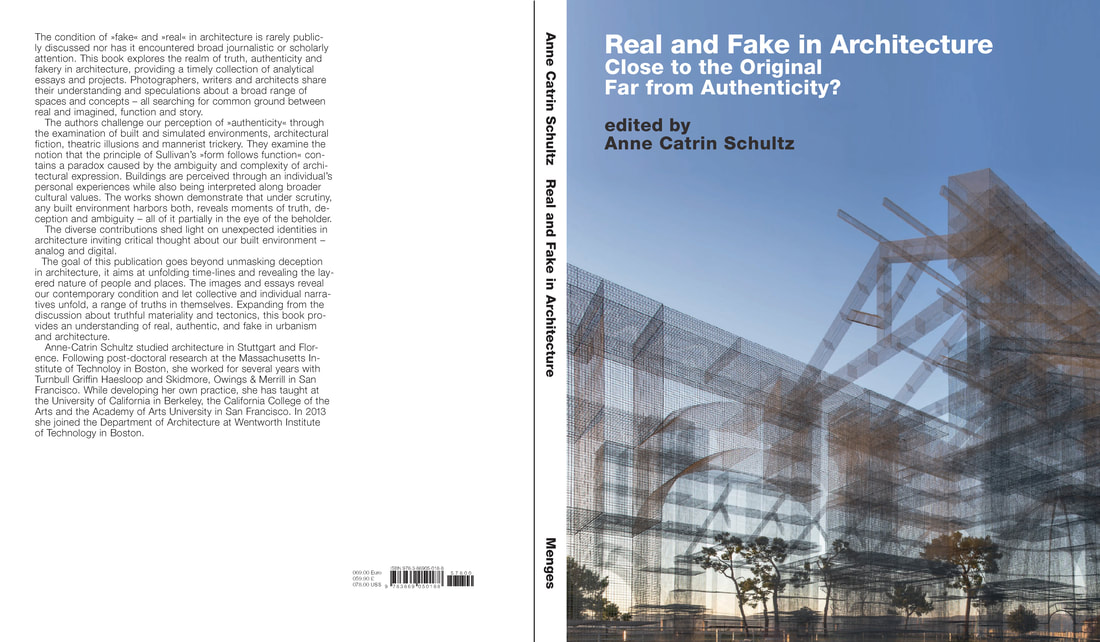| Design Innovation in Architecture: The Spatial Augmented Realities of UrbanScreen Essay by Christina Lanzl Edition Menges has published a new anthology by Anne-Catrin Schultz, Associate Professor of the Department of Architecture at Wentworth Institute of Technology. Through her research she realized that the condition of »fake« and »real« in architecture is rarely publicly discussed nor has it encountered broad journalistic or scholarly attention. This book explores the realm of truth, authenticity and fakery in architecture, providing a timely collection of analytical essays and projects. The authors challenge our perception of »authenticity« through the examination of built and simulated environments, architectural fiction, theatric illusions and mannerist trickery. Expanding from the discussion about truthful materiality and tectonics, this book provides an understanding of real, authentic, and fake in urbanism and architecture. The diverse contributions shed light on unexpected identities in architecture inviting critical thought about our built environment–analog and digital. Editor Anne-Catrin Schultz invited colleagues and friends to contribute essays: Dan Hisel, Morgan McMahon, Nicole Lambrou, Christina Lanzl, Eric Lum, Jennifer Lee Michaliszyn, Tom van Arman, Justin Vigilanti and Kemo Usto. Featured also are projects by Rima Abousleiman, Stefan Al, Alun Be, Kelly Hutzell and Rami el Samahy, Mat Maggio, Jessica Ronayne, Gregor Sailer, Allen Spore and Edoardo Tresoldi. The authors challenge our perception of »authenticity« through the examination of built and simulated environments, architectural fiction, theatric illusions and mannerist trickery. They examine the notion that the principle of Sullivan’s »form follows function« contains a paradox caused by the ambiguity and complexity of architectural expression. Buildings are perceived through an individual’s personal experiences while also being interpreted along broader cultural values. The works shown demonstrate that under scrutiny, any built environment harbors both, reveals moments of truth, deception and ambiguity – all of it partially in the eye of the beholder. The goal of this publication goes beyond unmasking deception in architecture, it aims at unfolding time-lines and revealing the layered nature of people and places. The images and essays reveal our contemporary condition and let collective and individual narratives unfold, a range of truths in themselves. Expanding from the discussion about truthful materiality and tectonics, this book provides an understanding of real, authentic, and fake in urbanism and architecture. Publication: Anne-Catrin Schultz (editor). Fake and Real in Architecture: Close To The Original, Far From Authenticity? Stuttgart: Edition Menges, 2020: 131-140. | Design Innovation in Architecture: The Spatial Augmented Realities of UrbanScreen Abstract | Essay by Christina Lanzl Design innovation in architecture frequently is the result of a continual, thoughtful consideration of human habitation, its evolution, research and experimentation. The innovation of materials in architecture and design is tested at a smaller scale, where experimentation can happen on modest budgets, in the incubator atmosphere of a workshop environment. Artistic applications and the internet, exhibitions and temporary installations or tradeshows serve as a platform to introduce new ideas, materials or groundbreaking scientific research to a public audience for the first time. At a large scale the intersection of research and innovation increasingly occurs in virtual environments, where ideas can be visualized without the pressure to invest in construction. This phase of theoretical application usually precedes prototyping or, at times, it may occur simultaneously. A most promising new technology with potential for development of neoteric applications for building façades is projection mapping, a process that maps projected light on the surface of any 3D form. The types of “fake” architectural façades (skins) thus created offer an opportunity for innovation in architectural design and permanent construction. Projection mapping is a burgeoning field. Therefore, this essay is limited to a case study approach. Particularly noteworthy are the architecturally inspired, “fake” designs by UrbanScreen, a cutting-edge practice based in Bremen, Germany since 2005. UrbanScreen creates cataclysmic possibilities of architectural design as spatial augmented realities that are projected onto iconic buildings. Opera Sydney in Australia, Romania’s Palace of Parliament in Bucharest, Houston’s Rice University, the Leopold Museum in Vienna/Austria and Kunsthalle Hamburg in Germany have staged dazzlingly symphonic and imaginative choreographies developed by the firm. The development of a generally poetic and magical theme on each of these buildings offers fertile ground for exploration. UrbanScreen concepts offer innovative visions for kinetic façade design leading to a series of relevant analytical questions. Which bright ideas may architectural designers deduce from temporary visualizations? Can the production of projected visuals and motion design inform permanent applications or, may this already have occurred? What kind of questions may arise concerning the digital interface and software codes when converting a projected to a static design? Can the visual drama and theatricality of a night-time projection that also features mesmerizing music and sound components be transformed into the design of a building envelope? This essay is intended to shed light onto these queries into fake architecture. |
|
2 Comments
|
Urban Culture Institute
The Urban Culture Institute Archives
May 2021
Categories
All
|

 RSS Feed
RSS Feed